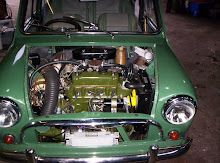Housed within the distributor body, beneath the contact-breaker baseplate, are two small bob-weights which are pivoted to a plate attached to the driving spindle so that they fly outwards, against the tension of retaining springs, as the engine speed rises. In doing so they rotate a sleeve that carries the cam, moving it further in the direction of rotation and thus advancing the ignition.
Provided that it receives regular lubrication, the centrifugal timing control seldom gives trouble. Sometimes a spring may break. If this happens, it is essential to renew both springs, making sure that they are of the correct part number for the engine, as their strength determines the shape of the advance curve. It is advisable to check the centrifugal control when the contact-breaker components have been dismantled for routine servicing as described earlier. It is necessary only to remove the screw that retains the cam on the shaft, pull off the cam, disconnect the vacuum control link from the peg on the upper, moving plate of the assembly and remove the two Phillips screws that pass through lugs on the fixed plate, into the flange of the distributor body. Make a note of the positions of the various washers and terminal tags as they are removed and also the relative positions of the slot in the cam that locates the rotor, and the offset driving dog at the base of the distributor shaft. It is possible to replace the cam 180° from the correct position.
When fitting new springs, great care must be taken not to overstretch them or distort the spring eyes.
Thursday, 15 October 2009
Automatic Advance-retard Mechanism
Posted by Info Mini Cars at 02:31
Subscribe to:
Post Comments (Atom)


0 comments:
Post a Comment